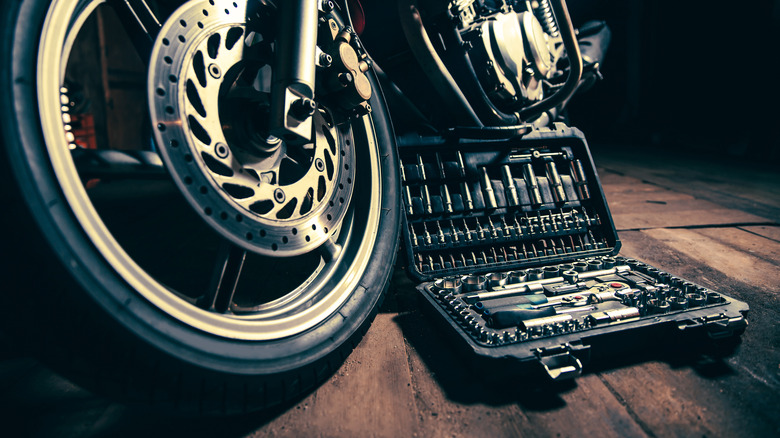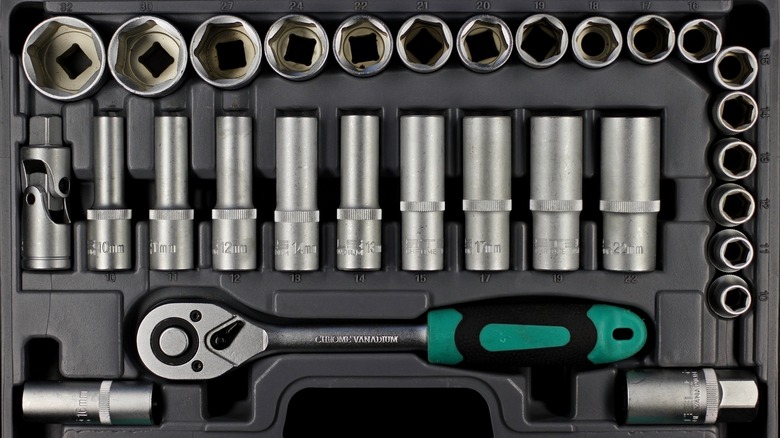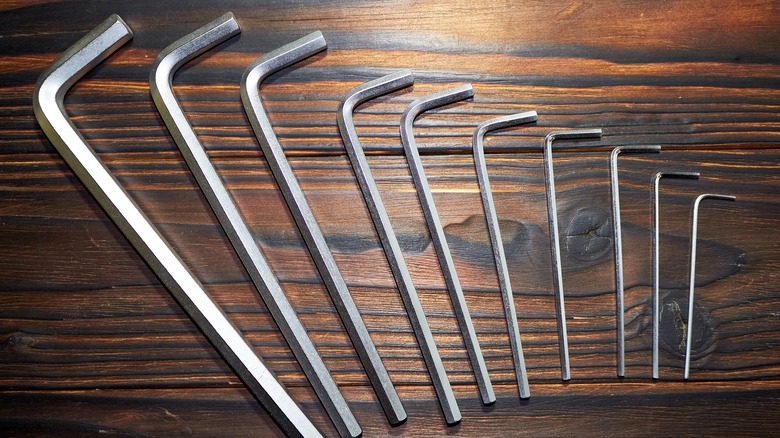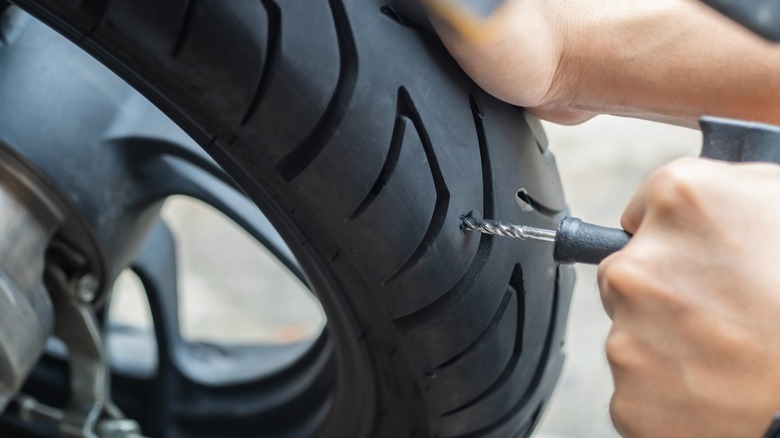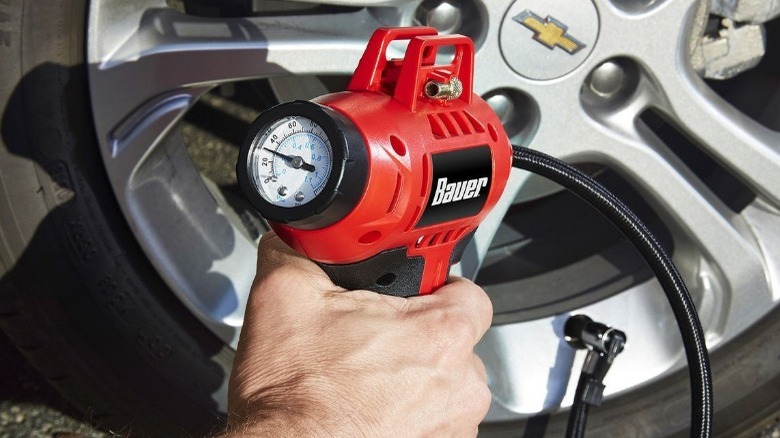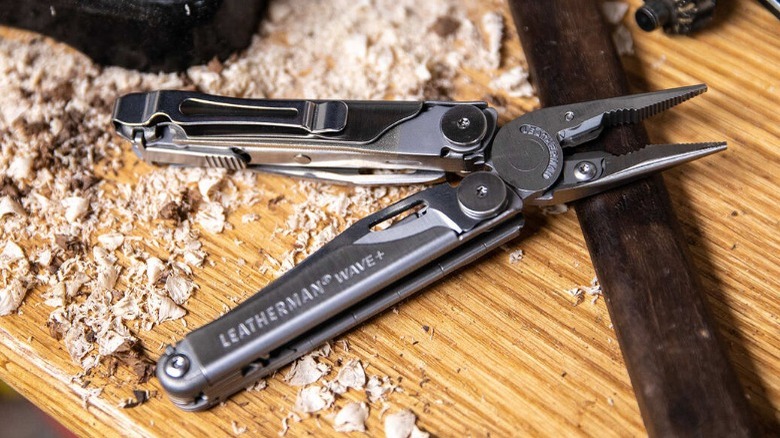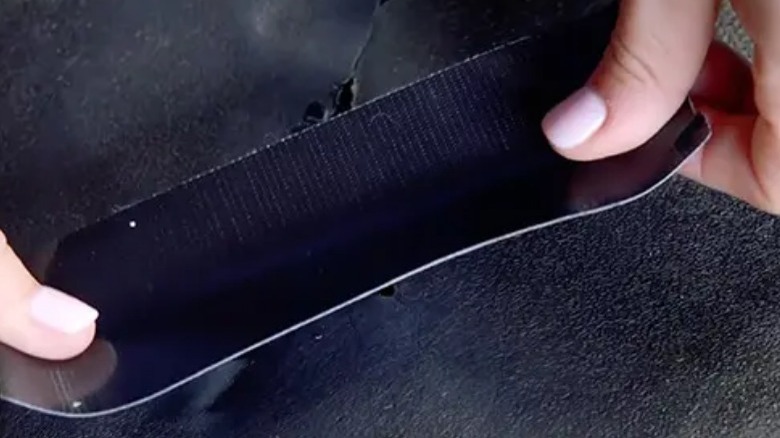Everything You Should Include In A Motorcycle Travel Tool Kit
We may receive a commission on purchases made from links.
Taking a road trip on your motorcycle can be an exciting experience. There's something uniquely thrilling about hitting the open road with nothing more than what you can cram in your saddle bags. But that doesn't mean you should head out the door with nothing but a toothbrush and a full tank of gas. You need to be properly prepared before you take a big trip, and there are a few things that you should definitely pack alongside your clothes and electronics.
I've been riding motorcycles for over fifteen years, and I can tell you that, just like any other vehicle, motorcycles can be subject to all manner of mechanical failures. A trip might start out smoothly, only for you to end up on the side of the road a few hours in. Take it from a guy who once had to hike four hours home through the desert-like drylands around the old Beale Air Force base in the California summer when his bike overheated -– it's much better to have the tools that you need on hand before you get into trouble.
But which tools should you bring? You obviously don't have an abundance of extra cargo space on your bike, so you need to make sure that the tools in your kit are compact and capable of helping you fix any issues you might encounter on the road. Here are a few of the best tools you should have on your bike before traveling.
Socket wrench set
It doesn't matter much what the make and model of your motorcycle is; just about every bike in the world is held together with nuts and bolts. They attach everything on the frame, from your side view mirrors to the coolant reservoir to the engine itself. There are a lot of situations where you might need to adjust these fasteners. You probably aren't going to want to take anything off your bike if you don't have to, but you may end up needing to clean out a fuel line if you get a clog or tighten a loose bolt here and there.
A full wrench set is big, heavy, and takes up a lot of room. Sockets, on the other hand, are small and work interchangeably on a single wrench. I would suggest getting an affordable set from somewhere like Harbor Freight and then keeping it in your saddlebags. If you want to save even more room, you can pick out all the different-sized sockets you might need and stash them with the wrench so that you don't need to bring the entire kit.
You might be tempted to just pack an adjustable crescent wrench instead, but that wouldn't be ideal. Crescent wrenches are big and awkward, and you might have a hard time gripping the bolthead tightly enough to break the torque seal on some of your fasteners.
Hex wrench set
Nuts and bolts make up a majority of the fasteners on most bikes, but they aren't necessarily all of them. A lot of bikes also use hex fasteners–particularly on fairings. These are rarely related to the source of any mechanical trouble, but you may have to take off a fairing or two to get access to the real problem. A fuel line leak, for instance, isn't easy to address if there's a big plastic outer shell keeping you from reaching the lower parts of the tank. You'll need a tool that lets you remove that shell so you can find the crack or leaky line and figure out how to stop it.
Hex wrenches, also called hex keys or Allen wrenches, are lightweight and take up very little space in your kit. They're a popular choice for furniture and machine work since they have more tension points than a standard Phillips head and don't strip as easily. The sets often come in sleeves of around 5-10 different-sized pieces that aren't too much bigger than a credit card, although this is another instance where you could pick out the sizes you might need and leave the rest if you want to conserve even more space.
Puncture repair kit
Of course, there's plenty of damage that can occur outside the chassis, too. The sad reality of a road trip in any vehicle is that you may eventually get a punctured tire. This is particularly bad on a motorcycle, as you don't have three other tires or a spare in the trunk to help you limp to the nearest service station. This is why it's important to have a puncture repair kit. Plugging a puncture may not be a permanent fix, but it can certainly help you get your bike to a shop that will put a new one on.
There are a few different kinds of puncture repair kits out there, but all of them are fairly compact. Mushroom plugs are good for small, cylindrical punctures (like what you might get from running over a nail), but string or rope plugs will fit a wider range of puncture shapes and sizes, making them a better all-around solution for your kit. Both of these can be purchased fairly cheaply and are compact enough that they won't take up much space in your saddle bags. Some holes might be too big to fix, but a good kit can make it so a minor puncture isn't the end of the world.
Air compressor and gauge
Punctured tires need to be refilled, and to do that, you'll need access to an air compressor. These are often readily available at gas stations, but that doesn't do you much good when you've got a flat in the middle of a 50-mile stretch of highway. Even if you don't get a flat, it's important to be aware of your tire pressure on longer trips. Keeping your tires full of air helps to ensure that you maintain proper traction on the road. It also makes the ride more comfortable and helps to prolong the life of your tires.
A battery-powered air compressor is the biggest item I would recommend adding to your kit, but that doesn't mean that it has to be massive. I personally use a Bauer 20V Cordless Inflator that you can get at Harbor Freight for just $20. This serves as both an inflator and a gauge that can be used to monitor the tire pressure. What's more, it's about the size of a flashlight, so it fits easily in my kit. Other brands, like Ryobi, Milwaukee, and Ridgid make similar handheld inflators, though these are definitely a bit more on the expensive side. Denvix makes one for $100 that's even more compact and doesn't rely on a power tool battery to operate.
Multitool
It's hard to say what kind of trouble you might encounter on the road, so it's equally hard to guess exactly what tools you might need to deal with it. You probably don't want to dump your whole toolbox into a saddlebag, but it's good to have a catch-all solution just in case you find yourself needing a tool to didn't think to pack, and a good multi-tool can take you pretty far.
There are a lot of multi-tools out there, and some of them are definitely better than others. Don't just buy the cheapest one you can find. You'll want to invest in one made of quality steel that won't bend, chip, or break when you need it most. You'll also want to make sure it has all the tools you might need for working on your bike. A screwdriver, pliers, wire strippers, scissors, and a file are all components that are commonly found on multi-tools which can each be situationally useful for roadside repairs. Gerber and Leatherman both make solid options that have all of the essentials built-in. You can always pack each of these tools individually if you would prefer, but that would take up a lot more space.
Tape
There is an old engineering adage that you can fix just about anything with a sufficient amount of duct tape. Now, I'm not going to say that duct tape makes for a good permanent solution to anything that might happen to break on your motorcycle, but it's very good at holding things together long enough for you to get somewhere that it can be fixed properly. Snapped off a side view mirror? Duct Tape. Seat sliding around underneath you? Duct tape. Crack in a coolant reservoir? Duct tape.
The combination of adhesion strength, tensile strength, and waterproof sealing properties that duct tape offers make it a must-have for any long-range motorcycle travel. I personally like using Gorilla All-Weather Tape, as it is even stronger, more waterproof, and more temperature-resistant than regular duct tape. It's also quite a bit thicker and more durable. It's very difficult to remove, though, so I wouldn't put it on anything you aren't planning to replace.
